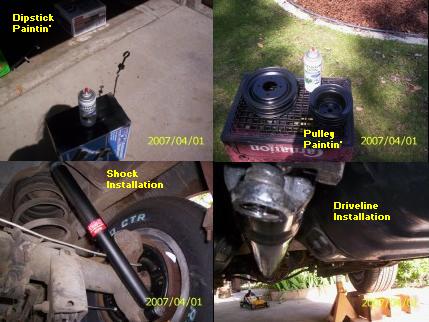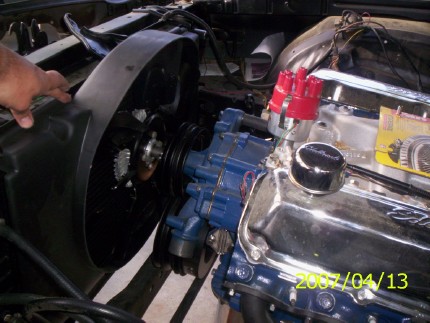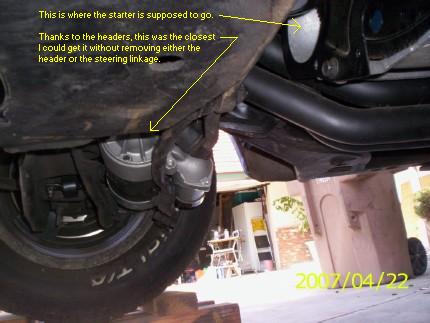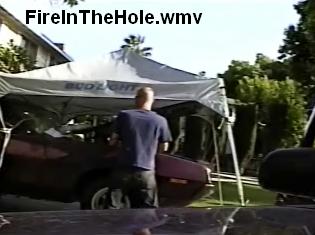After finally getting all of the big
stuff dealt with,
it was time to start sweating the details...

There were dipsticks & pulleys to
paint, shocks & drive line to install,
and emergency brake issues to deal
with....

Next came the main brakes...

Things were finally starting to click.
I had the pulleys and the fan installed:

It was starting to look like a real
engine...
An engine that might actually run (someday):

It was now time to install the starter.
Once again, those darn headers made
their presence known:

When faced with the prospect of either
removing the
header or the steering linkage, I opted
for removing the
steering linkage. I thought that it
would be easier:

After much whacking with a hammer and
a block of hardwood
(taking care not to mushroom the threads
on the tie rod ball joint stud)
the outer tie rod ball joint stud refused
to budge. I ended the day
and decided to obtain the ball joint
separator I so desperately needed.
Later that night, as luck would have
it, I was drinking beer and throwing
darts with my neighbor and his brother-in-law.
I was relating my tale of woe
with the starter, header, and tie rod
when the brother-in-law (who to my
knowledge at that point was a painter
by profession) revealed that before
he became a union painter in Indiana
he was an ASE Certified Master Tech.
I asked him if he wanted another beer,
and by the way,
"What are you doing tomorrow?"
Enter Rich Kackos.
An Indiana mechanic with a deep love
for all things hot-rod.
Not only did he solve my starter conundrum
in 5 minutes,
he also started all of the wiring that
was looming large on my horizon.
Shortly thereafter, we were ready to
crank the beast.
For this momentous occasion, I blew
the dust off of the video camera...
Ahh yes! the sound of a big block through uncorked headers!
Unfortunately, the electric fuel pump
that came with the car
was not pumping enough gas to keep
up with the engine.
So, we decided to get a new Holley
fuel pump.
Upon opening the box, Rich read the
installation instructions
and saw boldface type instructing the
installer to "mount the
fuel pump below the lowest point of
the fuel tank".
That prompted a second look at the existing
fuel pump;
not only was it mounted higher than
the gas tank, it was
also mounted upside down. Whomever
installed the
existing pump obviously didn't read
the instructions.
We probably could have re-mounted the
existing pump
and avoided the expense of buying a
new one...
Oh well... It's only money.
